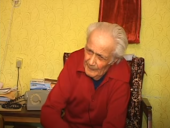
Abram Sharhorodskij ’s parents were also born in Rîbniţa. He grew up with two brothers and one sister. He first attended the local Yiddish school for seven years and then graduated from a Russian school. He was then trained as carpenter. During the war, he was imprisoned in the Rîbniţa ghetto from 1941, until he escaped in 1944. He was a forced laborer in a German hospital next to the ghetto. After his escape, he was drafted into the military and served from 1944 until 1947. He worked as tradesman for forty-five years.
The Ribnitser Rebbe
Rîbniţa , Moldova
Abram Sharhorodskij recalls the significance of Chaim Zanvl Abramovitsh, also known as the Ribnitser Rebbe, a mystic and Jewish religious leader active in Rîbniţa during and after the war. Abram describes how Abramovitsh, respected for his erudition and generosity towards the town's Jews, stewarded the community "like G-d himself" in the postwar period. Abram also tells how Abramovitsh fared in the Rîbniţa ghetto set up by the Romanians during the war. While Abramovitsh, according to Abram, was initially included in forced labor round-ups in the ghetto, he was later hidden by Bessarabian Jewish families in the ghetto and spared from this harsh treatment.
The figure of Chaim Zanvl (c.1890-1995) is mentioned in a number of AHEYM interviews. Famed as a wonder worker, healer, and teacher, he was revered by many Jews and some non-Jews in the region for his role in preserving and transmitting religious traditions in the postwar Soviet Union. After several decades facilitating clandestine spiritual activities in Moldova and Ukraine, Abramovitsh left the USSR in the early 1970s, eventually settling in the United States. Although he passed in 1995, Abramovitsh continues to grow in renown, especially in Hasidic circles where he is known as the Ribnitser Rebbe. His grave, a site of pilgrimage and a place credited as the source of miracles, is located in Monsey, NY.
Sebastian Schulman
